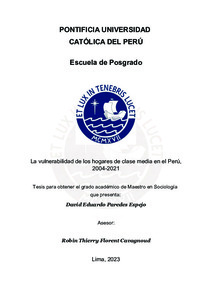| dc.contributor.advisor | Cavagnoud, Robin Thierry Florent | |
| dc.contributor.author | Paredes Espejo, David Eduardo | |
| dc.date.accessioned | 2023-10-25T18:58:23Z | |
| dc.date.available | 2023-10-25T18:58:23Z | |
| dc.date.created | 2023 | |
| dc.date.issued | 2023-10-25 | |
| dc.identifier.uri | http://hdl.handle.net/20.500.12404/26235 | |
| dc.description.abstract | La presente investigación consta de tres objetivos. El primero de ellos se propone
identificar a los hogares de clase media con la finalidad de aproximar el tamaño de
esta al interior de la estructura social peruana para el período comprendido entre
los años 2004 y 2021. Los dos siguientes propósitos persiguen denotar qué hogares
de clase media son vulnerables y cuáles son los factores asociados a la posibilidad
de tornarse vulnerable dentro de la clase media, respectivamente. Empleando
información de la Encuesta Nacional de Hogares panel para los años 2004 y 2021
se ensayaron diversos métodos tanto para la clasificación de hogares de clase
media como para la identificación de los vulnerables en su interior. Se encontró que
poco más de la tercera parte de hogares del país forman parte de la clase media en
las distintas aproximaciones ensayadas. No obstante, este conglomerado de
hogares no es estático. Entre la cuarta y tercera parte de hogares que la conforman
son vulnerables en el sentido de que experimentan movilidad descendente o no
tienen la posibilidad de mantener su nivel de consumo entre un año y el siguiente.
Ello mostraría que la clase media del país, pese a su constancia en tamaño, no está
estructurada. Tal variabilidad, en concordancia con el tercer objetivo, se explicaría
por variables tanto de índole macroestructural como de naturaleza idiosincrática.
Palabras clave: Estratificación social, movilidad social, vulnerabilidad | es_ES |
| dc.description.abstract | The following paper has three objectives. The first one concerns the clustering of
Peruvian households that belong to the middle class between 2004 and 2021. This
task's main purpose is to proximate the size of the Peruvian middle class throughout
the years. Secondly, after identifying the middle-class households, the next objective
is to select the vulnerable middle-class households. Lastly, having classified the
middle-class and vulnerable households within the middle, the last objective
determines the main factors behind the risk of being a middle-class vulnerable
household. Using longitudinal data from the Peruvian National Household Survey
(ENAHO) for the years in-between 2004 and 2021, several methods were employed
to classify middle-class households and select the vulnerable households within this
group. It has been found that around one-third of Peruvian households were
middle-class members, independent of the method employed in the identification
procedure. However, the middle class is neither a unique nor a homogeneous
group. Approximately one-fourth and/or one-third of middle-class households are
vulnerable as they experience downward mobility or cannot maintain their
consumption levels between one year and the subsequent one. This situation shows
that the middle class in the country, besides its size, is not structured. The
vulnerability in the middle class responds not only to the household's conditions
but is also influenced by variables over which the household has no control. | es_ES |
| dc.language.iso | spa | es_ES |
| dc.publisher | Pontificia Universidad Católica del Perú | es_ES |
| dc.rights | info:eu-repo/semantics/openAccess | es_ES |
| dc.rights.uri | http://creativecommons.org/licenses/by-nc-sa/2.5/pe/ | * |
| dc.subject | Clase media--Perú | es_ES |
| dc.subject | Economía doméstica--Perú | es_ES |
| dc.subject | Estratificación social--Perú | es_ES |
| dc.subject | Movilidad social--Perú | es_ES |
| dc.title | La vulnerabilidad de los hogares de clase media en el Perú, 2004-2021 | es_ES |
| dc.type | info:eu-repo/semantics/masterThesis | es_ES |
| thesis.degree.name | Maestro en Sociología | es_ES |
| thesis.degree.level | Maestría | es_ES |
| thesis.degree.grantor | Pontificia Universidad Católica del Perú. Escuela de Posgrado | es_ES |
| thesis.degree.discipline | Sociología | es_ES |
| renati.advisor.dni | 48857691 | |
| renati.advisor.orcid | https://orcid.org/0000-0002-0584-8620 | es_ES |
| renati.author.dni | 70011627 | |
| renati.discipline | 314567 | es_ES |
| renati.juror | Dammert Guardia, Manuel César | es_ES |
| renati.juror | Cavagnoud, Robin Thierry Florent | es_ES |
| renati.juror | Etesse Ruiz De Somocurcio, Manuel Louis Rumi | es_ES |
| renati.level | https://purl.org/pe-repo/renati/level#maestro | es_ES |
| renati.type | https://purl.org/pe-repo/renati/type#tesis | es_ES |
| dc.publisher.country | PE | es_ES |
| dc.subject.ocde | https://purl.org/pe-repo/ocde/ford#5.04.01 | es_ES |







